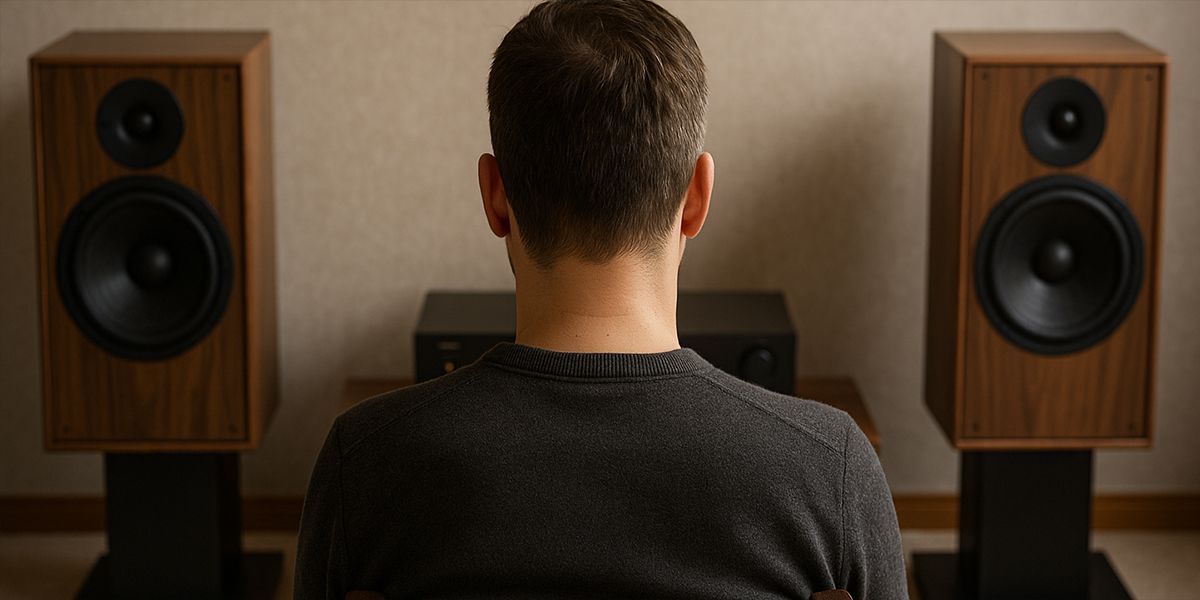AUDIO ORIGAMI BLOG

Close Encounters...
The science behind getting closer to your speakers.
You know what one of the biggest mistakes is when people set up their hi-fi systems? They sit way too far back. For some reason, no matter how big or small the room, people think the "sweet spot" is right against the back wall. It's as if distance automatically equals better sound. Spoiler alert: it doesn't.
Today, let's talk about close-field listening, sometimes called nearfield or midfield, and why getting closer to your speakers can transform your music experience.
Why closer feels better
Think of it like going to a live acoustic gig. If you've got the choice of a table right up front, near the musicians, or one tucked away at the back by the toilets, which one are you taking? Exactly—the front row. Because up close, you get intimacy. You can hear the texture of a voice, the squeak of a finger sliding across guitar strings. In audio terms, we call that presence—the feeling that the artist is right there in the room with you.
When you sit closer to your speakers, you reduce the distance between your ears and the sound source. That means your brain is receiving a cleaner, more direct signal before the reflections of the room get in the way. The result? Vocals sound more lifelike, instruments have better definition, and the whole performance feels more real.
The science behind it
Here's where acoustics comes into play. Sound doesn't just travel in a straight line—it bounces. Every surface in your room reflects sound waves: walls, floors, ceilings, even your coffee table. Those reflections reach your ears milliseconds after the direct sound, and your brain has to do the work of combining them. Too much reflection, and you get muddiness, echo, or that dreaded "boomy" bass.
By moving into the closefield zone - that's about two to three meters from your speakers - you dramatically reduce the energy of those reflections relative to the direct sound. In other words, you hear more of the music and less of the room. In physics, this is sometimes called improving the signal-to-noise ratio of your listening environment.
It's the same principle recording engineers use in studios. That's why mixing desks have monitors just a meter or so away - they want accuracy, not the sound of the room.
Big speakers, small rooms? Yes.
Here's another myth: "If you've got a small room, you need small speakers." Not true. In fact, large speakers can thrive in small spaces - if you're listening close.
Let's break it down. Bigger speakers move more air. More air movement means better bass extension, more dynamic range, and ultimately, more realism. And because you're sitting close, the room itself doesn't get as much chance to exaggerate or muddy that bass.
At Audio Origami, we've tested this in everything from big demo rooms with high ceilings to small 11-by-11 foot test rooms. Even in that tiny space, we run large Harbeth Monitor 40s - big, powerful speakers - and they sound effortless. Why? Because in close-field, the speakers don't need to strain. Less strain means lower distortion, and lower distortion means a smoother, more natural sound.
But what about "disappearing" speakers?
People sometimes say small speakers are easier to make "disappear"—meaning the sound detaches from the box and floats in the room. That's mostly because they don't pump out the same deep bass that interacts with walls and corners.
But here's the trick: in close-field listening, any speaker can disappear. Because you're hearing more direct sound and less "room", your brain localises the performance, not the box. Move them a little out from the wall, sit in that equilateral triangle position, and whether your speakers are bookshelf-sized or the size of small refrigerators, they'll vanish.
Wrapping up
So here's our challenge: try pulling your chair closer to your speakers. Shrink that triangle. Give yourself a week of close encounters.
You might find your system sounds more alive, more present, and more immersive than ever before. And if you don't like it? No problem. Push everything back and you're right where you started.
But don't be surprised if you never go back.
Here's a diagram of a perfect close-field set up...


